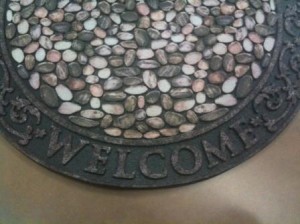Tuesday
Community Articles, World, otherAn Inspired Kind of Rawness
Cynthia Kneen expands on her experience teaching Shambhala dharma in South Africa. During her three months there, she gave three public talks, three radio interviews, Shambhala Guide training, an introductory weekend based on her book Awake Mind, Open Heart, a dharma art evening to a private group of Cape Town artists and activists, and Shambhala Training Levels I, IV, V, Windhorse and Drala.
Click here for all of Cynthia’s blog entries and reflections from South Africa.
Last week a joke was told in a group near me, followed by explosive laughter. The explosion came because the joke said the unspeakable. It was about the South African national flag, which is colorful, varied, and the like. The joke goes like this. “The red is for the land. The blue is for the sea. The green is for the maize (the corn). The white is for the whites. The black is for the blacks. And the gold stripe around the black is for the electric fence that keeps the blacks from the maize.” Ha, ha, the group erupted. Ha, ha, from white people who care immensely, who feel their hearts are breaking. The punchline? Power has changed, but the poor still aren’t being helped. I got the joke, of course, and of course I also didn’t get it, because its pain didn’t explode for me.
I visited Johannesburg’s Apartheid Museum. It is beautifully designed and executed, and exhausting emotionally. On a little space of wall, just before entering a grotto-like area that has replicas of early cave art from thousands of years ago, there are ten words printed in small elegant script on a tiny tasteful plaque. “Humanity was born in Africa. All people, ultimately, are African.” Just ten words. I love it.
On entering the museum a visitor is arbitrarily handed a ticket that says “White” or “Non-white” to reflect the apartheid-era laws. My ticket said “White,” so I went in a white entrance. Somehow I quickly found myself outside, walking up an incline with strategically placed mirrors that had painted on them larger-than-life photographs of contemporary South Africans. First I saw their backsides and myself in their mirror as I approached them, about to overtake them. Then their frontsides with me looking at them and seeing me in the mirror, too. Each person was so strong and interesting.
Finally, I was back inside the museum again where the displays are amazing. At most of them I wanted to weep. Only one made me laugh. The one that made me laugh was a full wall display of the government’s results one year on race reclassification──how many Malays had been reclassified as colored, how many Malays had been reclassified as blacks, how many whites had been reclassified as colored, how many coloreds had been reclassified as black, how many coloreds had been reclassified as Malays, how many whites had been reclassified as blacks. On and on it went. The government was really busy. On and on the government toiled and re-toiled to get things exactly, precisely, completely right. Naturally no blacks had been reclassified as colored, white or Malay.
Around the corner there were replicas of the government’s solitary prison cells, hanging ropes for executions, film documentaries of government figures making speeches, physical attacks on the townships, brutalities, more speeches by the authorities, caches of weapons, on and on. Even a huge, bright yellow, armored tank-type truck. Townships that had shacks built by the government deliberately had wide rows between buildings so these tank-like trucks could make u-turns and gunners had a clean sight. Then documentaries of Nelson Mandela, his imprisonment, jubilation at the new government that formed in 1994. Finally, television monitors interviewing contemporary South Africans, asking them about South Africa 2010, giving them a letter from the alphabet to start the conversation, and each one saying, “For A, I’d say ….” “Well, L would be for …” It was fabulous, just fabulous. The contemporaries being interviewed were ironic, intelligent, cagey, accurate, each of them passionate in a guarded way. No one is certain what will be the outcome for present-day South Africa, no one.
My impression is that South Africans love their country, even the ones who say, “I hate this f—g place.” There is so much rawness from its history, its revolution in power, its inspiring constitution. And now rampant corruption, embarrassing leaders, rising wealth for a few, and those who are poor are given nothing that was promised, nothing. Pockets of rural revolt. “Tik” (methamphetamine) and rape in the townships. Tension among the educated. Crime in urban centers. And throughout, individuals reacting in their own unique way to situations, trying to stay resilient, trying to get it right.Everywhere on street and rural corners you find people looking for income. The most enterprising have attitude, fresh produce or crafts, and a big grin. “Here!” and “No, no, not today!” are accepted equally. And equally a stopped car in a city can be smashed open any moment from a small mistake on the driver’s part. Unemployment and violence are running high. I feel respectful of the danger. I cut through a park in full daylight and my heart is racing. “How close is the danger?” a friend from the United States asks. Inches away, I say. An edge is everywhere.
During apartheid’s years, South Africans fled to The Democratic Republic of Congo, Zimbabwe, and other African countries to find safety. Now immigrants flee conflicts elsewhere in Africa, come to South Africa and are attacked for taking jobs. ANC youth fight ANC elders. Latrines in the townships aren’t serviced, or worse, are torn down during political wars within the ruling ANC party. In the ensuring conflict a township’s water pipes are ripped up, too. Now there is no servicing of latrines, no latrines, and no more clean water, either. “How can this happen when our new constitution is the best in the world?! Where are the jobs? Where are the services for the poor?? Why can’t the government get it right??!” Resilience, more resilience.
Last week depression descended on the country. No more vuvuzellas blown in the streets day and night, these plastic horns that drone during soccer games and rattle the enemy’s nerves. The soccer match didn’t go well for South Africans, and everyone is hiding, wounded, avoiding the streets.
All this takes place in a setting of extreme beauty and vigor. Right now, I am back in Cape Town, it is night, and the moon is rising over the sea. This moon is much closer here than at home, growing improbably and boldly. I can’t get used to it.
Most of all it is the trees that stun me. Locals say, “The trees have a hard time surviving here.” But, what are they talking about??! The trees grow straight up, boldly, from the ground. No curving in gracefully at the base, no sense of roots spread out like a canopy under the earth, no graceful stretch up to the sun. Just boom, up they go in one straight push. In the United States a tall tree is old and venerable, or so it seems to me. Here? A tall tree is young. Boom, up it goes!! I can’t explain how this has affected me. The Afrikaans word for “tree” is “boom,” so the joke’s on me.
It’s winter here below the equator, and my time in Africa is coming to a close. It is 7 a.m., and still it is pitch black outside, the full darkness of night. The moon is hanging over the bay, just above the sparkling night lights of Cape Town. It is hanging so close that for the first time I feel that the moon belongs to the earth, is made of the same stuff.
During the days I see the sign “Armed Response” everywhere in cities. During a weekend of teaching, I walk down a side street, and suddenly the clouds hang over me, as if within reach, just above the street. As I turn to look behind me, I see the back of a building with a charming winding outside staircase, perfectly petite and circular, spiraling up the side of the building. Just at the highest reach of a human’s arm there is a perfectly petite spiral of barbed wire curling along the charming staircase, over the top of a fence, and then around the property, and a sign, “Armed Response.” The spirals and charm of an old decaying European-style house, worn down by the relentless force of salt water and wind from the sea, with its faded warning, “Armed Response.” Behind the building the mountain, the f—g mountain, a giant presence just beyond the BP petrol station, which has its own sign, “Armed Response.”
________________________
 Cynthia Kneen is the author of Awake Mind, Open Heart: The Power of Courage & Dignity in Everyday Life (Avalon, 2002), and the CD course, Shambhala Warrior Training (Sounds True, 1996). Cynthia has taught Shambhala Buddhist programs throughout the mandala for over thirty years and is currently writing a book on business and dharma. Visit her website at www.cynthiakneen.com
Cynthia Kneen is the author of Awake Mind, Open Heart: The Power of Courage & Dignity in Everyday Life (Avalon, 2002), and the CD course, Shambhala Warrior Training (Sounds True, 1996). Cynthia has taught Shambhala Buddhist programs throughout the mandala for over thirty years and is currently writing a book on business and dharma. Visit her website at www.cynthiakneen.com







Nov 7, 2010
Reply
One of my all time favorite books is a history of South Africa called “My Traitor’s Heart” by Rian Malan. A central theme is the rawness and intensity of the land, the culture, the history. And elegantly written. Great insights into human relations.